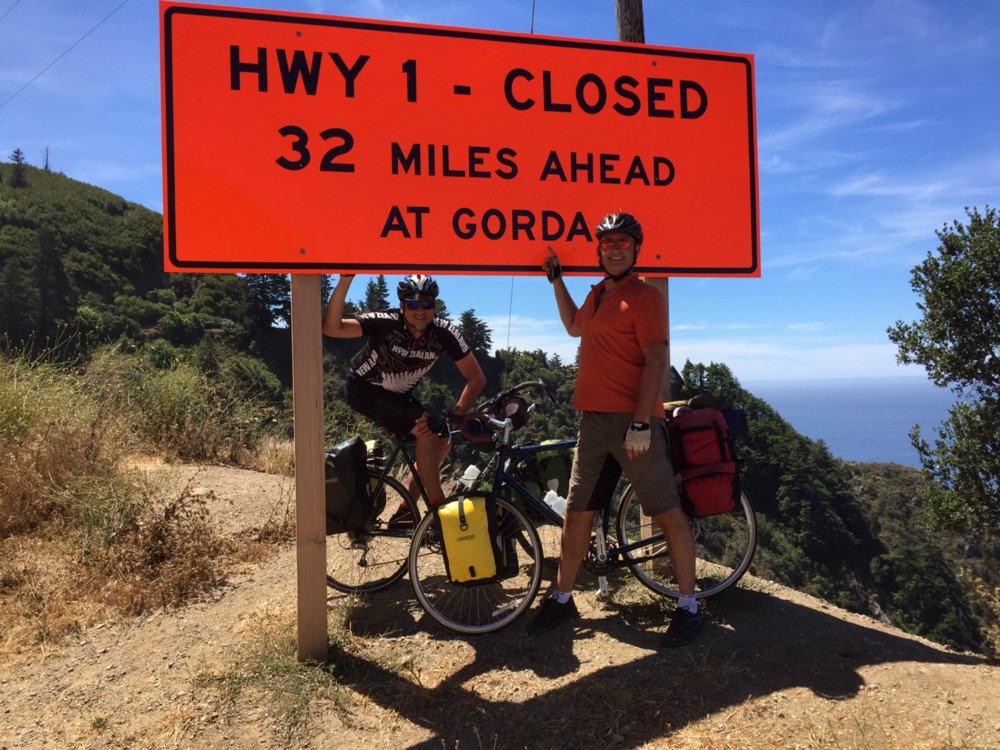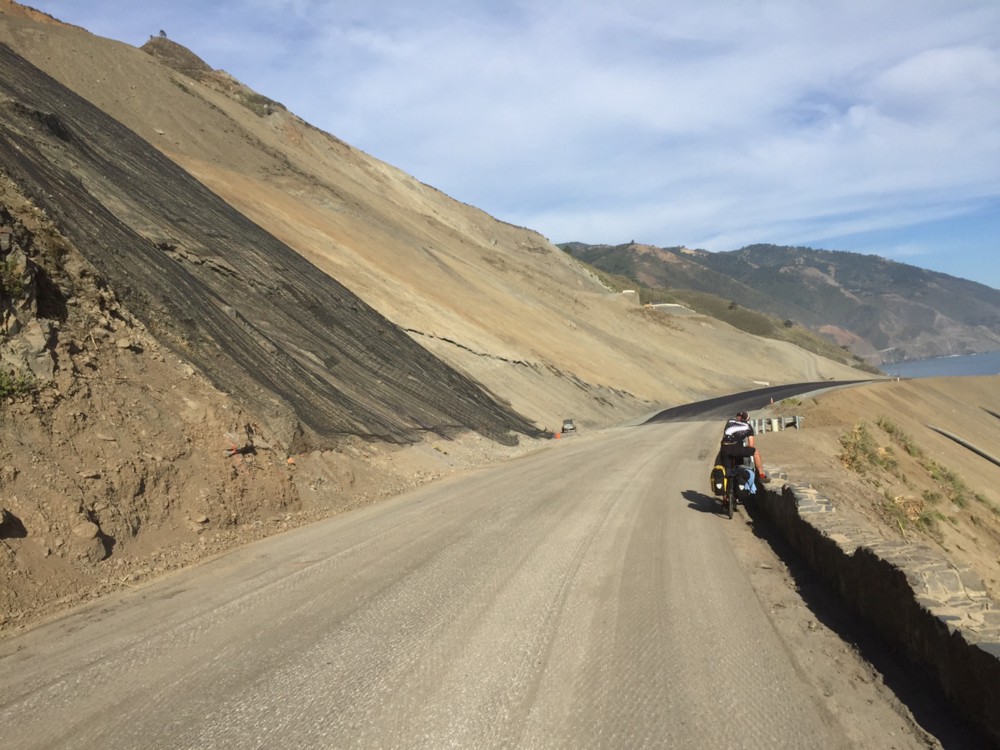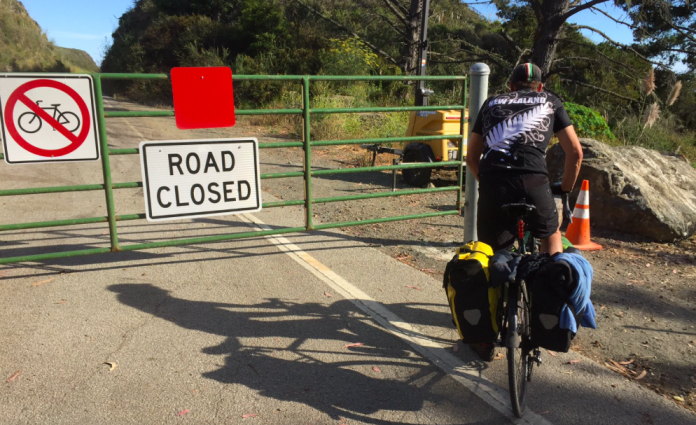We met them in Lucia, which is less a town than a remote store and restaurant along California’s coastal highway, 13 miles north of the road closure.
Their son had biked through the closed section of Highway 1 two weeks earlier and urged them to take advantage of this last chance for epic coastal bicycling, car-free. Well, almost car-free in their case.
They drove down from their Sacramento home and were getting ready for a bike ride on the dead-ended road to Gorda and back. But we were riding all the way through — and we were excited to hear their son had made it without incident.
It was the first direct confirmation we’d heard that cyclists were getting through without trespassing tickets or other official hassles. For the past four nights at hiker-biker campsites from San Francisco through Big Sur, it has been the talk of the camps.
Everyone had developed a similar strategy, informed by word-of-mouth and some scattered bits of online advice. Just wait until the construction workers got off work around 5 or 6 and ride on through. Easy…supposedly.
There aren’t any good detours once you’ve committed to the coastal route this far so there was a lot riding on the question, particularly for those pedaling from Canada to Mexico, a summer-long pilgrimage more popular with young Europeans and Canadians than Americans.
So we chatted with this sweet couple, probably in their late 50s, learning what we could and then wishing them a good ride as they pedaled off, he on an electric-assisted bike and she self-powered, just like us.

As Andrew and I continued south on our journey, I pondered this couple and their son. They lovingly celebrated his outlaw journey through the landslide-caused road closure, which was now just a week away from reopening. And they even took his advice to drive all the way down here to do this beautiful, peaceful ride.
This family seemed to get what most Californians had missed: the year-long closure of Highway 1 may have been bad for vacationing motorists from Southern California and the scattered small businesses that rely on them, but it was a rare opportunity for a more intimate encounter with this beloved coastline.
It had been a long hot journey since we left the Pfeiffer Big Sur campground that morning, so we stopped at Sand Dollar Beach to plunge into the Pacific Ocean and lounge on the beach, watching the pelicans glide along the crashing waves. We had time to spend on leisure before our crossing.
As we closed in on the closure, we saw the couple on their return trip and we exchanged smiles and waves. They looked happy.
We arrived in tiny Gorda a little after 5pm and saw some construction workers lingering at the closure, warily eyeing the fully loaded bike tourers who were arriving solo or in pairs. They seemed to know our intentions, but we were patient and still needed to grab a bite and fill our water bottles and bag for the long, rugged stretch of coastline ahead.
The woman who worked in the store said this had become a daily ritual over the last two weeks. The closure was monitored 24 hours a day until about a month ago, she said, and then word slowly seeped out that the coast was now clear for cyclists once the workday was done.

As soon as the construction workers left around 5:30, the four other cyclists quickly took off, riding around the fence labeled “Road Closed” and another sign with a bicycle icon with a red slash across it.
It was still another 12 miles through the closure to the Ragged Point Inn and more than 30 miles to the next campsite in San Simeon, through the longest, steepest climb of our whole week-long ride, so it was important to get a jump on the coming darkness.
But we were thinking about renegade camping within the closure itself in the Los Padres National Forest. So we finished eating, slowly pulled our gear together, and rode off a little before 6 pm.
Sure enough, there were no problems getting past the gate, where we even posed for pictures of our long-anticipated transgressive feat. We joyously pedaled past the massive landslide at Mud Creek and the engineering marvel that overcame it and kept Highway 1 clinging precariously to the edge of the continent. The road was basically done and just awaiting some final paint before the cars returned.
Leaving the two-mile-long slide area, we rode past another road closure checkpoint and a solitary construction worker still sitting in the back of his pickup truck. “Your photo was taken when you crashed the gate and there’s a ticket waiting for you at Ragged Point,” he said with a snide smirk as we rode past him.
We had a long climb to ponder that possibility, which seemed doubtful, but you never know. He was probably just fucking with us — yet we soon changed into different shirts nevertheless, just in case.
But really, it didn’t matter. If a fine for trespassing was the price we had to pay for this epic car-free bike ride down the California coast, so be it. And as long as we were scofflaws anyway, we camped the night at the old boarded up ranger station at Salmon Creek, which had the post-apocalyptic feel of a scene from the Walking Dead.
Later that night, as we drank our wine and gazed toward the long steady ascent that faced us in the morning, we saw a solo cyclist slowly pedaling up the hill under cover of darkness. Atta boy.
Then early the next morning, we followed him up and out of the closure, riding those final four miles and blowing past the road closure at Ragged Point with sly smiles on our faces, the worker at the gate paying us little heed.
And it was another five miles before the first southbound car passed us, ending our reign over California’s coastal highway.
Read more of Steven Jones’s writings on the environment and other topics here.




